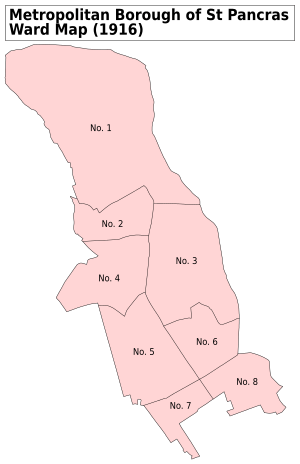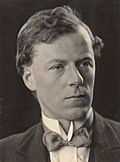Quick facts for kids {{{Name}}}
[[{{{Type}}} constituency]] |
[[Image:{{{Map1}}}Constituency.svg|120px|]]
[[Image:England{{{Map2}}}.svg|120px|]] |
| {{{Name}}} shown within [[{{{Entity}}}]], and {{{Entity}}} shown within England |
| Created: |
{{{Year}}} |
| MP: |
{{{MP}}} |
| Party: |
{{{Party}}} |
| Type: |
House of Commons |
| County: |
[[{{{County}}}]] |
| EP constituency: |
[[{{{EP}}} (European Parliament constituency)|{{{EP}}}]] |
St. Pancras South West was a constituency represented in the House of Commons of the Parliament of the United Kingdom. It elected one Member of Parliament (MP) by the first past the post system of election. It was created in 1918 by the division of St Pancras South into South East and South West divisions, and abolished in 1950.
Boundaries
The constituency comprised the south western part of the Metropolitan Borough of St Pancras. It consisted of wards Four, Five and Seven, as they existed in 1918.
In 1950 the constituency was split between Holborn and St Pancras South (wards Five and Seven) and St Pancras North (ward Four).
Members of Parliament
Elections
Elections in the 1910s
Elections in the 1920s
| General election 1922: St Pancras South West |
| Party |
Candidate |
Votes |
% |
±% |
|
Unionist |
Richard Barnett |
8,289 |
49.4 |
-9.2 |
|
Liberal |
Arthur Comyns Carr |
5,533 |
33.0 |
-5.5 |
|
Labour |
George Horne |
2,947 |
17.6 |
New |
| Majority |
2,756 |
16.4 |
-3.7 |
| Turnout |
16,769 |
57.9 |
+12.7 |
|
Unionist hold |
Swing |
-1.8 |
|
| General election 1923: St Pancras South West |
| Party |
Candidate |
Votes |
% |
±% |
|
Unionist |
Richard Barnett |
7,097 |
42.0 |
-7.4 |
|
Labour |
George Horne |
5,321 |
31.4 |
+13.8 |
|
Liberal |
William Charles Pilley |
4,505 |
26.6 |
-6.4 |
| Majority |
1,776 |
10.6 |
-5.8 |
| Turnout |
16,923 |
56.9 |
-1.0 |
|
Unionist hold |
Swing |
-10.6 |
|
| General election 1924: St Pancras South West |
| Party |
Candidate |
Votes |
% |
±% |
|
Unionist |
Richard Barnett |
11,877 |
57.9 |
+15.9 |
|
Labour |
Ernest Bennett |
8,630 |
42.1 |
+10.7 |
| Majority |
3,247 |
15.8 |
+5.2 |
| Turnout |
20,507 |
66.9 |
+10.0 |
|
Unionist hold |
Swing |
+2.6 |
|
| General election 1929: St Pancras South West |
| Party |
Candidate |
Votes |
% |
±% |
|
Labour |
William Carter |
12,010 |
45.6 |
+3.5 |
|
Unionist |
Patrick Spens |
10,231 |
38.8 |
-19.1 |
|
Liberal |
Haydn Davies |
4,103 |
15.6 |
New |
| Majority |
1,779 |
6.8 |
N/A |
| Turnout |
26,344 |
62.0 |
-4.9 |
|
Labour gain from Unionist |
Swing |
+11.3 |
|
Elections in the 1930s
| General election 1931: St Pancras South West |
| Party |
Candidate |
Votes |
% |
±% |
|
Conservative |
George Mitcheson |
18,737 |
71.4 |
+25.6 |
|
Labour |
William Carter |
7,514 |
28.6 |
-17.0 |
| Majority |
11,223 |
42.8 |
N/A |
| Turnout |
26,251 |
62.5 |
+0.5 |
|
Conservative gain from Labour |
Swing |
+21.4 |
|
| General election 1935: St Pancras South West |
| Party |
Candidate |
Votes |
% |
±% |
|
Conservative |
George Mitcheson |
13,035 |
55.0 |
-16.4 |
|
Labour |
James Edmond Sears |
10,670 |
45.0 |
+16.4 |
| Majority |
2,365 |
10.0 |
-32.8 |
| Turnout |
23,705 |
59.4 |
-3.1 |
|
Conservative hold |
Swing |
-16.4 |
|
General Election 1939–40
Another General Election was required to take place before the end of 1940. The political parties had been making preparations for an election to take place and by the Autumn of 1939, the following candidates had been selected;
- Conservative: George Mitcheson
- Labour: Haydn Davies
Elections in the 1940s
| General election 1945: St Pancras South West |
| Party |
Candidate |
Votes |
% |
±% |
|
Labour |
Haydn Davies |
9,533 |
61.9 |
+16.9 |
|
Conservative |
Lionel Heald |
5,862 |
38.1 |
-16.9 |
| Majority |
3,671 |
23.8 |
N/A |
| Turnout |
15,415 |
61.2 |
+1.8 |
|
Labour gain from Conservative |
Swing |
+16.9 |
|



